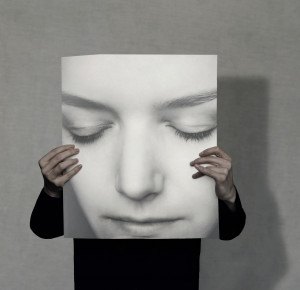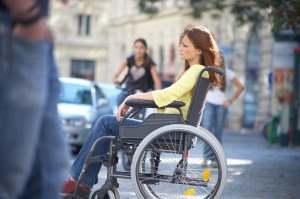Each time we are told that we ‘look good’ or ‘look well’ by people who have little concept of even the lengths we have gone to just to connect with them at all, it carries with it an additional pain of appearing ‘well’ or ‘normal’ despite how awful we actually feel.
Our culture does its best to ignore the existence of illness, especially when that illness is chronic, invisible, complex, and as a consequence, doesn’t fit inside the mainstream idea of what ill-health means or apparently ‘looks like’.
Instead the focus is on the beautiful, the youthful and the healthy, as if in denial of ageing and illness. Mainstream media also seldom caters for those with ill-health, disability, limited mobility or pain but exclusively the ‘well’ population.
So when you live with a condition that defies others’ ideas of chronic illness or cannot be placed neatly in a box, sadly it’s often us who are expected to explain and even defend the very symptoms that thwart our entire lives.
You Don’t Look Sick

Living with constant pain, disability and limitations means that your life is already full to the brim with challenges. Yet our inability to ‘be well’ coupled with looking healthy presents further challenges, from being disbelieved and poorly treated, to being judged or repeatedly advised on how to ‘heal’ ourselves.
“The biggest grievance those with chronic conditions have is that their loved ones often do not believe what they are going through is real, because to others they ‘look good’. Sadly, this makes the person feel as if they are being called a liar or a wimp. This can cause great strains on relationships between friends, family members and spouses,” says chronic illness patient and advocate at the Invisible Disabilities Association, Sherri Connell.
“Ironically, those with chronic conditions would like nothing more than to gain complete control of their lives and not have to adjust to any limitations at all! Nonetheless, their bodies do not always cooperate with their desires, no matter how much they want it to.”
CRPS, with its excruciating, constant pain and mystifying symptoms, is so difficult to understand that even our own families and loved-ones may prefer denial to compassionate support and care. Symptoms such as allodynia for instance, such as a breeze causing searing, burning pain or sound sending our pain levels soaring, are so far from general understanding that even those closest to us may be filled with dismissive disbelief.
Fibromyalgia and CFS [and many other painful chronic conditions too] also force patients to deal with such an extensive list of symptoms that they too have to deal with an onslaught of doubt, disbelief and even criticism from those they care about or, if able to work, from those they work with too.
You’re Meant to Get Better

It’s accepted when someone has acute pain because of a recent injury or through surgery. It’s also accepted if someone is unwell but then they are supposed to get better. When we don’t improve and our symptoms even worsen, it is us who are frequently thought to be exaggerating, faking or simply not trying hard enough to rejoin the well world.
This is compounded by the fact that in spite of CRPS, CPS, fibromyalgia or chronic pain and illness, we usually look healthy. As if anyone would ever choose ill-health, isolation and all the other less thought of but extensive aspects of living with painful chronic conditions, much less miss their own beautiful lives. It’s already tough enough dealing with pain and illness, without the added burden of disbelief.
“Regrettably, a travesty occurs when the person not only has to contend with no longer being able to do what they love to do, but also has to battle for their loved ones belief, respect and understanding. While the person with the illness/pain is mourning their loss of ability and freedom, others often accuse them of just being lazy or malingering,” says Sherri Connell.
Self-Blame
When you ‘look healthy’ but feel broken inside, it’s easy to feel it’s your fault that your body has broken down in some way, as if it’s a personal failing. Though you would never force that assumption on another, we are so frequently hardest on ourselves, further adding to the burden of loss and ill-health.
It’s as if in some distorted way we punish ourselves for our own body ‘failing’ us. When your body feels more like an octogenarian’s than young or middle-aged, you are forced to adapt your life accordingly and that also causes pain.
The pain of a life un-lived or a life lived in a way that is so unlike how you imagined, so limited and thwarted that you feel a constant sadness, whether you express it or not, which can add to this self-blame and lead to us not always speaking kindly to ourselves.
Yet to move forward and find a little internal peace in spite of this sadness and resistance to change is to speak kindly to yourself and let go of any self-blame. If you find yourself struggling with this, read How to Use Pain Psychology Techniques to Reduce Anxiety, Depression, Anger and Guilt for some powerful and effective tools to help you cope.
Chronic Pain is Age-Neutral

The expectation of good health by our culture is especially hard when chronic illness and pain begins so early in life. My own CRPS began six weeks after my 22nd birthday (fibromyalgia four years later), and I know others who had even less life before losing all concept of comfortable and freedom at such a young age.
When it all starts as adult life is only just beginning or even yet to begin, instead of mourning the life we lost, we mourn the life we never were able to live. There are also additional pressures from friends who we long to go out with, dance with or even simply sit outside with but suddenly can’t.
It’s normal to face added pressures from families too. Despite the average age of onset being well past child-bearing age, many young people who struggle with chronic pain and illness have had to give up dreams of having a family or living a normal life and that hurts even more.
The flip-side of this is already having a family when chronic pain or a pain condition strikes and having the guilt over not being as active a parent as one had dreamed of. I know mothers with CRPS who are naturally devastated at not being able to be the parent they could have and long to still be.
The isolation can be devastating, as we are forced to adjust to a life of relative social isolation, as many loved-ones drift away from what they may see as a dubious diagnosis or at the very least, one that to them seems impossible to understand.
Convincing the World it Hurts
It adds to the stress of living in pain when you have to also try to convince the world that your symptoms and pain are real. As invisible illness or disability is so misunderstood it often falls on the one in pain to educate others, or even simply defend their own symptoms.
“It’s always nice to be told you ‘look so good’ because we know the person’s intent is to make us feel better,” says Lisa Copen, patient and founder of the Invisible Illness Awareness Week. “But I also think that for people who feel terrible, it’s another way they feel that people don’t understand the seriousness of their illness and immediately close themselves off to anything else the person has to say.”
Initially your friends and family may respond with concern and compassion, while others may be more distant. Some people are simply uncomfortable with illness. As weeks turn into months and months into years, even those who were originally sympathetic may question the existence of an illness that is invisible and incurable, or they may simply feel too uncomfortable to acknowledge it.
Supporting Yourself
Living with, managing and coping with a complex chronic illness and pain can naturally make us isolated, anxious, vulnerable, and depressed. Adding the disbelief of those we care about can crush us, especially when some friends and family drop away but it is vital to remember that you are doing the best you can given your particular set of circumstances.
Also that things can and do improve, they may not improve as much or as swiftly as we would like – no one wants to live in pain – but there are still good things ahead of us. Allowing ourselves to feel how we feel and the grace to accept where we are regardless of the opinions of others, can help us make it through.
Of course it would be easier, far easier if we had the support of others who we care for but that isn’t always possible. The kindest thing you can do for yourself is to support yourself regardless. If you are feeling depressed, read How to Cope and Heal Depression When You Have Chronic Pain and Illness and reach out for support, whether online or in person.
Hiding Your Pain
Years of constant pain can make us masters in the skill of hiding our pain. Everyone with severe pain knows that we can and do have moments where we appear to be almost normal, not that it feels like that from this side of the window. The pain can be horrific but we choose to hide it to lessen the burden of others.
No one likes to see another in pain and moaning about it or indeed grimacing or wailing, it doesn’t help the pain, patient or their loved ones. Just as we struggle with an illness that is so tricky to understand, others find it even harder to comprehend because they not only cannot see the pain that we also become adept at knowing how to hide it.
We don’t want to express the physical pain all the time and when you live in constant pain, there is little point in doing so. Exhibiting your high pain levels only serves to make others uncomfortable. They do not know how to react and not being able to alleviate your pain can make loved-ones also feel helpless and sad.
So we hide it but that, of course, makes the less understanding of souls also delude themselves into thinking our pain is reduced or far less severe than it truly is. Ironically, the act of forever hiding our pain actually works against us in a medical setting when even pain specialists themselves forget how adept we become at hiding the true level of our pain, and us unable to truly show it.
The more years in pain, the more your own personal pain scale shifts. To begin, everything feels like 8/10 or higher but when 8/10 is your new normal, that slips tp a 7/10 or even a 6/10, reserving the higher numbers on the pain scale for the truly horrific flare-ups.
Being Judged on One Moment
Every pain patient knows how difficult it is to constantly adjust to unpredictable symptoms and fluctuating pain levels. Our limitations may allow us to engage in an activity one day that is completely impossible to contemplate the next, or even again that same day. You may be able to walk 5 metres but afterwards it may take two hours to recover from that.
Variable, chronic and complex conditions and our own ability and function can never be gauged by a single isolated activity, yet we are so frequently misjudged by others if they see us looking nice or being active in any way. Healthy people tend to assume it’s all or nothing: we’re either ill or we’re well; we’re either in pain or we’re not. If we’re seen doing anything ‘normal’ [they assume] we must feel good.
The reality is that we would have not only prepared extensively for every activity – and have had to pace every activity – but also are guaranteed to be pinned to the bed afterwards through a flare-up of pain.
Many who live with severe and painful conditions can only manage one ‘big’ activity a day, especially if it involves leaving the house. If that day has a medical visit for example, everything pivots on that single activity and appointment. The tiny one or two-hour window in which we see others may have taken the entire day to prepare for and more to recover from. Others may be able to do more, some even less.
Being Judged When We Need to Cancel
Nothing hurts more than to have someone dismiss your pain or treat you with scepticism and resentment but unfortunately, it happens and far too frequently.
It’s such a sad fact but a true one that when we are forced to cancel an event at the last minute, we are heartbroken and our body is broken too.
Whether through the sheer exertion of preparation for the event or simply flaring-up but the whole day resting for it and avoiding doing the things we love takes an extra beating when our loved-ones dismiss our cancellation, entirely unaware of just how much has gone into our trying to see them, not to mention the heartache and sadness at not being able to see them or get out of the house or bed.
Happy is Not Healthy
Many symptoms of our chronic pain condition(s) are entirely invisible. We aren’t all in wheelchairs or use walking sticks, in fact only 8% of disabled people are permanently in wheelchairs. Nor do we all share the same obvious symptoms.
Since chronic pain, exhaustion, and the seemingly endless symptoms can seldom be seen, others frequently have a hard time believing that anyone who looks healthy or is in any way animated can have so many profound symptoms and limitations. Yet our happiness is so often confused with being healthy or miraculously cured.
As the majority of our lives are spent in isolation and always in pain, we do light up when in company but only briefly. After that brief visit – that we no doubt had to rest before and prepare for – we collapse and can do absolutely zip but this is as hidden as our symptoms and rarely acknowledged by others who are more dismissive of our condition and pain.
We often appear to be healthy, especially when we help manage our condition(s) with good nutrition, gentle movement/stretches, deep breathing and meditation – all these things help to blur the barrier between happy and healthy – something that only serves to magnify the many problems associated with invisible illness.
Some pain patients go to great lengths to look far healthier than they are and feel but to the detriment of their symptoms or increased disbelief from others. Pacing is a wonderful tool but on occasion, we have to choose our battles and ask ourselves if the psychological benefits of leaving the home to see friends outweighs the elevated symptoms, bed rest and high pain after the event or activity.
Finding Support
Find support in the ever-increasing array of pain communities around the globe. The internet has brought so much to those house-bound and in pain. We are no longer so isolated or at the mercy of the sometimes vicious opinions of others who simply do not understand and choose to be cruel in their denial instead of kind, and we can always be kind to ourselves.
There are some great support sites online , while counselling if possible for you, can help many pain patients handle both the invisible symptoms but also the guilt they can feel at looking well, but feeling awful; looking well, but not being well; looking well, but being incapable of doing tasks at which they used to excel.
Follow these links for open letters to ‘healthy’ people that really help others understand: Letter to Normals, Letter to Those Who Do Not Have CRPS/RSD
Doing the Best We Can
We can do our best to educate those closest to us, to help them understand our invisible illness but it is also vital to end our our evaluations of ourselves based on what others choose to believe. Not everyone will understand, as we know all too well, and we cannot allow that to affect our own self-worth.
Next time you are told that you ‘look good or ‘look well’ or ‘don’t look sick’, instead of allowing yourself to be saddened by this and the many other burdens of illness and pain, choose to focus on your own beating heart.
Feel that pulse of life within you. You are important, you matter, you may be burdened with challenges of chronic illness and pain but you still have the final freedom of choosing where you put your mind.
If You Love Someone in Pain
Appearances can be deceiving, and are rarely an indication of health or how someone truly feels. If you love someone who lives with invisible illness, take the time to learn all you can about their condition and listen to what they have to say. Instead of saying, “You look well”, try “You look good but how are you really feeling?”
Your compassion, understanding and genuine care is the rarest thing in the world to your loved-one living in pain, no matter which painful condition they face. Obviously some have more awareness than others but regardless of what you know outside of your interactions, listen to your loved-one. A little understanding instead of judgement or disbelief is the kindest offering you can make.
Feel free to share your thoughts in the comments below or in the Guest Book if you like what you see. ♥
You can also sign-up to the Princess Post and receive a free Flare-Up Toolkit here:
[avatar user=”jomalby” size=”thumbnail” link=”www.princessinthetower.org” target=”_blank”] Gentle hugs x[/avatar]
You may enjoy ~
A Narrative Review of the Impact of Disbelief in Chronic Pain
On the Stigma of Living with Chronic Pain








Well said. Thanks for helping others visualize something we have a hard time seeing ourselves.
I do often feel the question, “How are you feeling?” has become as loaded or tricky as “do these jeans make me look…”
It’s taken over 8 years for me to realize we need tough or difficult days to help us cherish and celebrate all our good moments.
Thank you for your lovely comment Kim. I totally agree, it’s such a tricky thing. Especially when we want to look as well as possible but then find we’re faced with criticism. Your point about the cherishing and celebration of good moments really touched my heart, love that. Gentle hugs and healing blessings ♥ x
I wish you had been around many years ago. You are a gift and gem to so many!! So glad to have met you on Twitter!
I really enjoyed reading your article – thank you for sharing !! I have lived with the diagnosis of systemic sclerosis (scleroderma) and raynauds for 17 years, (another princess in a tower), accompanied with constant chronic pain. I found your article to not only being most inspirational, but also very informative and thorough, as to the actual daily reality of living with an invisible diagnosis. Thanks again for sharing, and sending you lots of wellness wishes !!
Thank you for your lovely comment Nikki and so lovely to connect with you on FB too 😀 Thank you also for sharing and spreading the love. Sending you wellness wishes, healing hugs and far finer days. ♥ x
This is so spot-on. When I am up to going out, I try to wear make-up, fix my hair, and plaster a smile on my face. And yes, I get “no one would know you’re sick!” All the time. And “you look so good!” I thank hem and tell them I put a lot of effort into trying to look good.
Totally agree, often our efforts to look as well as possible are so frequently returned with doubt. So pleased you enjoyed it and thank you for your comment. I hope today is a better day for you. 🙂
Absolutely fantastic blog post. Will so follow your blog (stunning layout!).
From reading it, it only makes my blood boil even more because we should NEVER have to justify anything to others if only they would take some time to ASK US what our illness is like, as opposed to THEIR imaginative, medical, internet knowledge of OUR illness.
Thank you so much Billie, so happy you enjoyed it. You’re completely right, it’s a shame that people judge so freely, entirely unaware of how hard it is in each moment, let alone for life. I hope awareness spreads a little further though some are so fixed in their ideas of ‘what illness is’ or ‘looks like’ that it makes it all the more difficult when we don’t for that tired picture. Thanks for your fab comment! I hope today is a better day. ❤ x
The reason I make myself look nice daily is because it is one thing I can control…I’ve gone for days in lazy clothes with hair pulled up and it makes ME feel worse. It is truly wonderful to hear every feeling I have put into words…just the way I would write them down…you know exactly how I feel….its not just me but the syndrome of chronic pain and fatigue….WOW a powerful realization…thank you…
Leslie, it’s my absolute pleasure and honour to transcribe those feelings so many share into words. I know so many of us have such a tough time with this. Even with those who one day seem to have understanding, fluctuate in their belief. Yet to put that effort (and use those spoons!) to make yourself feel and look good is a wonderful thing and I agree so much, on the days when pain is too high to, or other symptoms severe, we do feel worse. It’s a shame that we are often so judged for our efforts and invisible symptoms but equally, it’s lovely for me to read your comment too as can so relate. 🙂
Thank u for your article my husband has a lot of pain from and injury and several different chronic disease none of which have flags that r waving so he looks pretty good other then a small limp because most people don’t notice he can’t sit very long or stand or anything but a really short time his pain level is a 4 thats a good day and I have bad health thyroid disease fibromyalgia arthritis and a stroke that affected only my brain and I have something called transit global amnesia which none of the above show outside of my body so I look fine but I am way from find so we’re both fight the judging us and we fight our best to just work together and get though best we can some days that’s ok some not so much so your saying what we were feeling but could not put into words was wondèrfu thank u so much
Thanks for your kind comment Kristy and so pleased my post resonated for you. It must be even more challenging for you both to have to deal with invisible illness, pain and complicated symptoms. Healthy people are, quite naturally, so unaware of just how much goes into every activity, let alone the excruciating payback and symptoms after every event, no matter how humble it is. Wishing you both strength and the understanding of others and so happy you like my blog. ♥ x
I also do the same thing as you. I will lay around in my comfy clothes, hair up and no make up and every time I look in the mirror it makes feel even worse. So I decided this is the one thing I can control. Even though showers are like falling lava on my foot, I still take a shower and do my make up for me!
I have CRPS in my right leg, mid thigh down to my toes and oh, my toes are the worst! I had a neurostimulator done 3 weeks ago and it truly has been live changing. My pain on normal days is tolerable, still something that a “normal” person wouldn’t be able to handle.
This is my time, I refuse to let this horrific disease take over my life. CRPS is not who I am.
Thank you for a wonderfully written blog! As I was reading I was constantly nodding in agreement. Thank you for putting this into words. 🙂
You are so welcome JLyn. I loved reading your comment. It’s so true, especially the lava showers! There’s courage in your comment, and so happy that the neurostimulator is helping you too. Truly wonderful news. 😀
Thank you! This article completely validates everything I feel. I recently had a doctor say “you look healthy enough”. It’s difficult enough to know your family and friends don’t really believe the extensive list of symptoms but there are doctors who just don’t get it either.
I rarely go out anymore and when I do I am such a master at hiding the pain that it’s no wonder no one believes me. I’ve long since given up trying to explain so I just pretend normal.
Reading this article makes me feel less alone and a little less crazy 🙂
So happy you enjoyed it Dawn and thank you for your lovely comment. It’s such a tricky thing when we become so used to hiding our pain that it’s almost more difficult to show it, especially after so many years of keeping it hidden. Sometimes it far easier to pretend, for us and for others who would feel uncomfortable if we actually showed the true reality we live with. Have a far finer week Dawn with much, much less pain than usual. ♥ x
I didn’t understand WHY my husband always thinks I “down-play” my pain – levels on my Pain Management Doctors Monthly pain scale sheet. Now I know and I know how to explain it to my husband and doctor!
Many Thanks!
You’re welcome, Rose. So pleased this is useful and resonated with you. Gentle hug ❤️
Thank you for this article. I need to connect more with people who understand this sort of thing. Others try to help, but don’t realize how it comes across. Very rarely do I even mention being in pain, but on a particularly bad day I told a close friend that my leg was really hurting (I have a blood clot that they tell me will never go away down my entire leg, among other things) and my friend tells me I should be ashamed of complaining since at least I still have a leg when others have lost theirs. That might be true, but at that moment when I felt like I could gnaw my own leg off because it was hurting so bad, it’s probably best to say something like “I’m sorry you’re in pain” and leave it at that.
Excellent article about my life!
So glad you enjoyed it, Brett!
This is so accurate! I often say I don’t want to look as bad as I feel, but sometimes I just can’t do it. Well done!
This article was so emotionally healing for me. I just cried in happiness. Thank you so much! Feel much less alone.
Being overweight I find some people seem to think that if I just lost weight that I’d be fine. They believe it’s only the weight therefore my own fault. In one sense I don’t blame them because for so many years I also thought it was the weight causing my problems. When I got worse the more time passed and the more I tried to exercise, I finally realised that being heavy should not make me as disabled. From there I finally got a diagnosis. What a relief! However, some people still believe that it’s my weight and that hurts. Has anyone else had this happen?
I have three children with chronic fatigue and brain fog. In the past I’ve struggled with feeling “crazy, irrational, over emotional, over protective” and have been called as much. I know I’m doing what’s right for my kids. If I sometimes get something wrong, at least I know that I did it for the right reasons. I can live with that. My biggest struggle is when family thinks we should be able to pitch in where we can not. Their negative reactions can crush. In your article you’ve painted a picture for me of a place where someone understands and solidifies what we experience. Even helping me understand better myself. It is a blessing to hear such encouragement. I will read this again and again.
Dear Author, I am grateful for you taking the time to write this article. I have read it again and again for many years now as my three children deal with invisible after affects caused by a virus. Each time after reading it I feel understood, sane, no longer along, and more importantly, motivated to move forward. I hope this article stays online for more years to come and it blesses many others who find themselves facing the world with their illness.